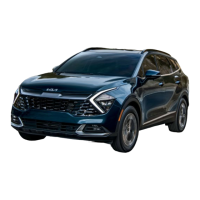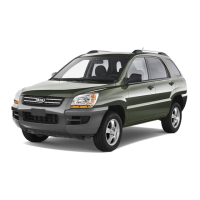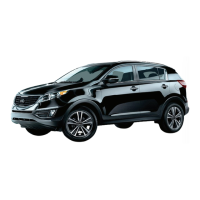
Do you have a question about the Kia Sportage 2024 and is the answer not in the manual?
| Brand | Kia |
|---|---|
| Model | Sportage 2024 |
| Category | Automobile |
| Language | English |
Details on the type of fuel your vehicle requires, including octane rating and alcohol content.
Information on vehicle modifications and their potential impact on performance, safety, and warranty.
Precautions for the first 600 miles (1,000 km) to ensure optimal performance and longevity.
Information about the Event Data Recorder (EDR) and the data it collects during crashes.
Identifies and explains the exterior features of the vehicle, including front and rear views.
Details the various controls and features located within the vehicle's interior.
Explains the layout and functions of the instrument cluster and associated controls.
Identifies key components located in the engine compartment for maintenance purposes.
Essential safety guidelines covering seat belt use, child restraints, air bag hazards, and driver distraction.
Instructions on adjusting front and rear seats, including lumbar support and headrests.
Information on the proper use, adjustment, and care of seat belts, including warnings and precautions.
Guidelines for selecting and installing child restraint systems, emphasizing rear seat placement.
Explains the operation, components, and safety precautions related to the vehicle's advanced air bag system.
Information on vehicle keys, including battery replacement, recording key numbers, and aftermarket keys.
Instructions on locking and unlocking vehicle doors using the smart key, mechanical key, and central lock switch.
How to operate the power liftgate, including opening, closing, and non-opening conditions.
Operation of power windows, including one-touch and auto up/down features, and the power window lock button.
Operation of exterior and interior lights, including battery saver, headlamp delay, and lighting controls.
Explanation of the different ignition switch positions and their functions, including illuminated ignition.
How to start and stop the engine using the ENGINE START/STOP button, including different positions.
Operation of the automatic transmission, including shift lever positions, paddle shifters, and shift lock system.
Information on the AWD system, including modes, advantages, and precautions for off-road and slippery conditions.
Details on power brakes, parking brake, ABS, ESC, DBC, HAC, VSM, and active air flap systems.
Tips for safe braking, including checking the parking brake, driving through water, and avoiding pedal resting.
Advice for driving in hazardous conditions like rain, hydroplaning, flooded areas, and reducing rollover risk.
Tips for safe winter driving, including tire care, snow tires, tire chains, and checking fluids.
Guidelines for towing trailers, including weight limits, hitch installation, safety chains, and trailer brakes.
Explains the FCA system's basic function, settings, operation, and limitations when using the front camera.
Information on the LKA system, its detecting sensor, settings, operation, and limitations.
Explains the BCA system's function, settings, operation, and limitations, including detecting sensors.
Information on the SEW system, its settings, operation, and limitations, including detecting sensors.
How to use the MSLA system, including setting speed limits, pausing, resuming, and turning it off.
Details the ISLA system, its settings, operation, and limitations, including warning methods.
Explains the DAW system's basic function, leading vehicle departure alert, settings, operation, and limitations.
Instructions on setting, increasing, decreasing, temporarily pausing, resuming, and turning off Cruise Control.
Information on SCC, including its basic function, operation, settings, and limitations.
Explains NSCC operation, settings, display, and limitations, particularly on highways.
Details the LFA system, its detecting sensor, settings, operation, and limitations.
Information on HDA system, its detecting sensors, settings, operation, and limitations.
Explains RVM settings, operation, detecting sensors, and limitations.
Details BVM function, settings, operation, detecting sensors, and limitations.
Information on SVM, its detecting sensors, settings, operation, and limitations.
Explains RCCA function, settings, operation, and limitations, including detecting sensors.
Details PDW function, settings, operation, and limitations, including detecting sensors.
Information on Forward/Reverse PDW, its detecting sensors, settings, operation, and limitations.
Explains PCA function, settings, operation, and limitations, including detecting sensors.
Instructions on using hazard warning flashers and what to do in case of emergency driving situations.
Steps to take when the engine does not start, including checking fuel, battery, and starter connections.
Procedures for jump-starting a vehicle, including warnings about battery safety and jumper cable connections.
What to do if the engine overheats, including checking coolant level and safety precautions.
Information on TPMS operation, low tire pressure telltale, and malfunction indicators.
Instructions on using the Tire Mobility Kit for temporary tire repair, including components and sealant application.
Steps for changing a flat tire using the spare tire, including jack usage and safety precautions.
Explains the information provided on the jack label, including model name, load capacity, and jacking instructions.
Guidelines for towing services, including proper lifting procedures and precautions for AWD vehicles and side/curtain airbags.
Tips for towing trailers, covering weight limits, hitch installation, safety chains, and trailer brakes.
Identifies key components in the engine compartment for maintenance checks and servicing.
Details on normal and severe usage maintenance schedules and precautions.
Explains the purpose and checks for various maintenance items like engine oil, drive belts, and fuel filter.
Information on checking and changing engine coolant, including safety precautions and warnings.
Instructions on checking brake fluid level and handling brake fluid, with warnings about contamination and usage.
How to check and refill washer fluid, including warnings about using the correct fluid and avoiding damage.
How to check the parking brake's stroke and ensure it securely holds the vehicle.
Instructions on replacing the air cleaner filter, including operation and precautions.
Information on climate control air filter inspection and replacement procedures.
Guidance on inspecting and replacing wiper blades, including front and rear wiper blade replacement.
Tips for best battery service, including maintenance, risk of explosion, recharging, and resetting items.
Information on maintaining recommended tire pressures, tire rotation, alignment, and replacement.
Provides the overall length, width, height, tread, and wheelbase specifications for FWD and AWD models.
Details the engine specifications, including displacement, bore and stroke, firing order, and number of cylinders.
Provides luggage volume measurements for different configurations, including dual-level floor options.
Provides tire size, load capacity, speed rating, inflation pressures, and lug nut torque specifications.
Lists recommended lubricants and fluids for the engine, transmission, coolant, and brake system.
Information on roadside assistance, toll-free consumer assistance, and emergency roadside assistance services.
How to report vehicle safety defects to NHTSA and Kia America, Inc.











